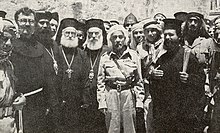
Back الإعمار الهاشمي للمقدسات الإسلامية في مدينة القدس Arabic האפוטרופסות ההאשמית על המקומות הקדושים בירושלים HE Pelayan Bait Kudus Yerusalem ID



Hashemite custodianship refers to the Jordanian royal family's role in tending Muslim and Christian holy sites in the city of Jerusalem.[1] The legacy traces back to 1924 when the Supreme Muslim Council, the highest Muslim body in charge of Muslim community affairs in Mandatory Palestine, chose Hussein bin Ali (Sharif of Mecca) as custodian of Al-Aqsa. The custodianship became a Hashemite legacy administered by consecutive Jordanian kings.
Jordan controlled East Jerusalem and the West Bank in 1948, and annexed the territories in 1951 until they were lost to Israel during the 1967 Six-Day War. Jordan renounced claims to the territory in 1988, and signed a peace treaty with Israel in 1994, whose ninth article states that Israel commits to "respect the present special role of the Hashemite Kingdom of Jordan in Muslim Holy shrines in Jerusalem" and that "when negotiations on the permanent status will take place, Israel will give high priority to the Jordanian historic role in these shrines." In 2013, an agreement between Jordan and the Palestinian Authority recognized Jordan's role in Jerusalem's Muslim and Christian holy sites.
Al-Aqsa and the Dome of the Rock were renovated four times by the Hashemite dynasty during the 20th century. In 2016, King Abdullah II participated in funding renovation of Christ's tomb in the Church of the Holy Sepulchre, and in 2017, Abdullah donated $1.4 million to the Jerusalem Islamic Waqf, the Jordanian authority responsible for administering Al-Aqsa. An independent report estimates the total amount that Jordan and the Hashemites have spent since 1924 on administering and renovating Al Aqsa as over $1 billion.[2]
Intermittent violence at the Temple Mount between the Israeli Army and Palestinians evolves into diplomatic disputes between Israel and Jordan.
- ^ "Jordan's Christians throw weight behind King's pro-Jerusalem push". The Jordan Times. 19 December 2017. Retrieved 18 January 2018.
- ^ "Amid Temple Mount tumult, the who, what and why of its Waqf rulers". Dov Lieber. The Times of Israel. 20 July 2017. Retrieved 14 January 2018.